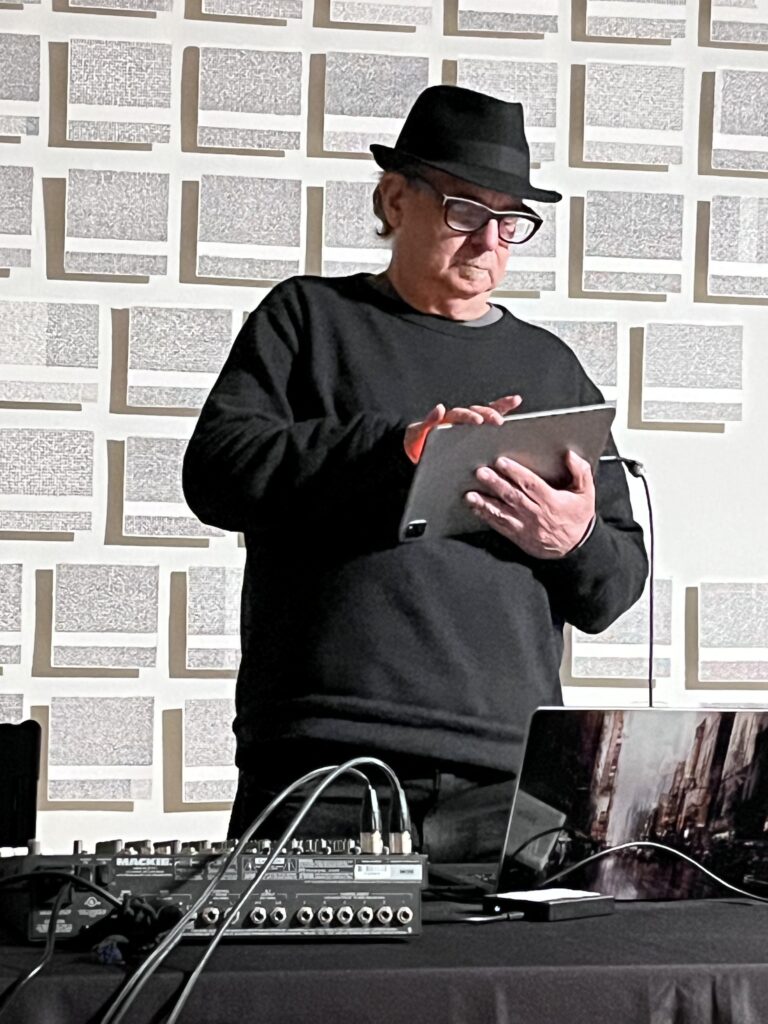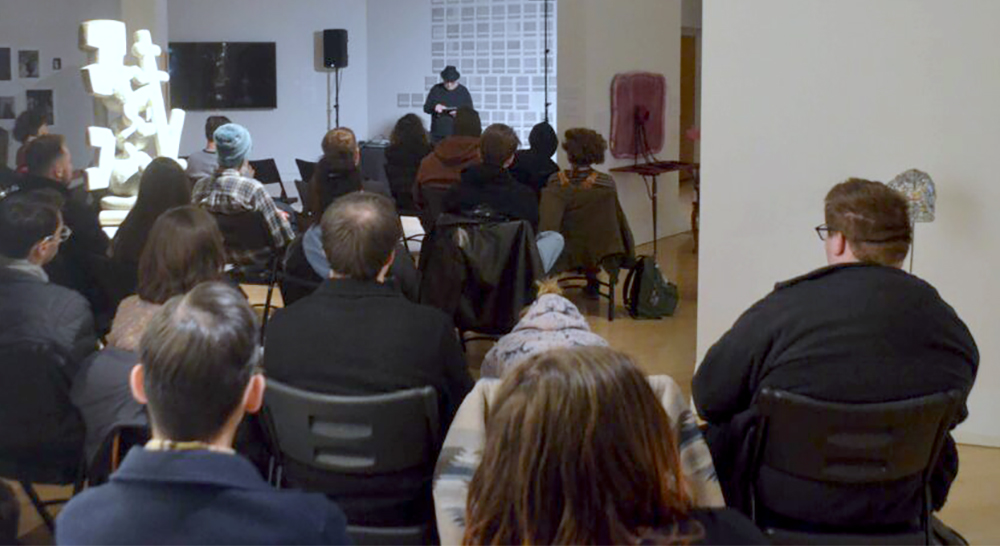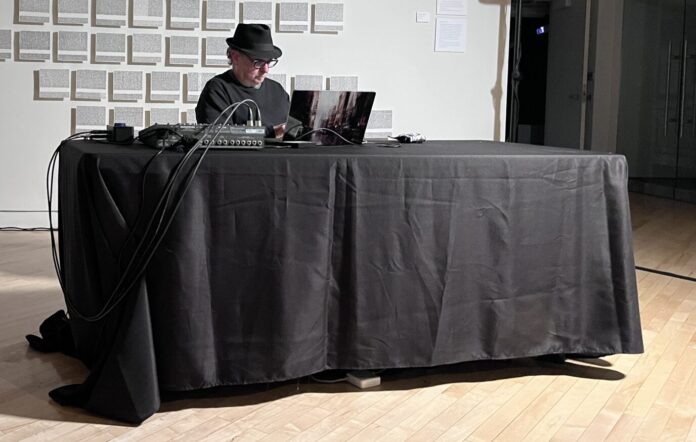Pioneer of live computer compositions performs BGSU concert
BOWLING GREEN – When Carl Stone steps into the spotlight, dressed all in black with black-rimmed glasses and a black fedora, he appears to be a quiet, unassuming, cool jazz cat. You wouldn’t think of him as a disrupter, but beneath his stoic exterior, that’s exactly what he is.
Stone is a 71-year-old artist and composer who, since the 1970s, has been using digital samples and computers to create songs that defy words and musical definitions.
In concert Dec. 2 at Bowling Green State University, Stone’s only instruments were a small laptop computer and an iPad.
Staff and volunteers had to keep adding chairs as more and more people – a total of about 60 – ambled into the Dorothy Uber Bryan Gallery/Fine Arts Center, vying for vantage points around the partial walls of art displays and a large sculpture in the middle of the floor.
After being introduced by Kurt Doles, director of the MidAmerican Center for Contemporary Music, Stone picked up his iPad, acknowledged the boisterous applause with a nod and a smile but no words, and opened the concert with Kurihara, the first of eight electronic tunes he would spin over the next hour and 15 minutes.
The song floated into the air on gentle waves of rising, falling, climbing and sliding tectonic textures, propelled by steady but spare drumbeats and occasional clicks and crashes, all interwoven with sampled human voices that glided through the rhythmic mix.
Stone stood behind a black-draped table holding the iPad in both hands, touching or sliding a thumb across the screen to change up the mix of prerecorded sounds. He stared intently at the screen as he manipulated his sonic collages, at times bobbing his head, swaying his body to the rhythm, or leaning forward and backward into the musical mix.
Most of the songs presented that night, Stone said later in an interview with the Toledo Free Press, were so new they have not yet been titled.
The second song was startlingly loud and aggressive, a controlled cacophony of electronic samples that started with a snappy drum beat, then quickly plunged into undulating keyboard tones with robotic syntax.
Some of Stone’s compositions featured beats and harmonies built on earthy, world-music foundations, swirling with the funky rhythms and intricate vocal harmonies of Soweto and South African folk music.
Others soared into the stratosphere with baroque elements mixed with waves of sci-fi tones, somewhat like a group of holographic monks chanting in a jungle on Pandora.

One of Stone’s new songs began with a snappy jazz drumbeat that segued into layered orchestral samples washing across snippets of “dooby dooby doos” and other vocal slices from the crooner classic Strangers in the Night.
There were always multiple layers of action and tones, rhythm and beats, moods and emotions – sonic collages that could serve as the backdrop for Christopher Nolan’s next Inception.
Stone did not talk about or explain his music to the audience. The only spoken words during the concert were “Thank you” and “Thank you very much” as the audience clapped and cheered at the end of each tune.
In an interview after the concert, Stone said that the iPad is “just a controller” that he uses to adjust the sonic samples.
“I’m mixing, but it’s more than just mixing; it’s live processing,” he said. “So, I have samples that we recorded on the hard drive, and I play them back and manipulate them in real time.”
That combination of recorded samples and live mixes means every song is unique to the moment.
“The pieces at this point are kind of structured, and they are worked out in advance, but the note-by-note details can be different every time,” Stone said.
He noted that none of the vocals in his music are synthesized; they are all sampled.
Stone has won numerous awards for his compositions and has performed concerts around the world. A native of Los Angeles, he divides his time between L.A. and Tokyo.
One of the pioneers of electronic music, Stone said that when he started in the 1970s, he was using synthesizers and tape recorders to compose.
“The technology has evolved so much. Back when I started, you needed a studio that cost many hundreds of thousands of dollars in equipment. Now the power of that studio can be found in an iPad app for $25, probably.”

“I loved it,” Amberlin Leonard said after the show. “I’ve been listening to him for a couple of years now. His mixes are so diverse that it creates an interesting world.”
Leonard said she lives in Detroit and made the 90-mile drive to Bowling Green to see Stone live.
“I’m a fashion designer so I really, really like the diversity of his music. That’s how I create fashion, with mixes of different eras and different cultures, so I relate to his music a lot. Most of the time I tend to like his more ethereal mixes and pieces, because it’s lighter, but I’m still moved and inspired by it. But I enjoyed seeing the more loud and intense and chaotic pieces live. It’s probably the most awesome thing I’ve seen in a long time.”
She said that the way Stone used vocal samples on Strangers in the Night reminded her of the way the late DJ Screw sampled Phil Collins‘ vocals on “In the Air Tonight.”
Doles, who said he has been friends with Stone for about 30 years, last brought the composer to BGSU in 2014.
“I like to bring him around every decade or so just to stir things up. I think it’s very important that our students hear what he has to say. Because he uses just a laptop and he uses samples as his primary input, it makes him very unique.”
He added with a laugh that Stone’s compositions sound something like “pop music from Venus.”
More information on Carl Stone can be found online at rlsto.net.





















